Role of Faults in Hydrocarbon Leakage in the Hammerfest Basin, SW Barents Sea: Insights from Seismic Data and Numerical Modelling
Abstract
:1. Introduction
2. Geological and Structural Setting
3. Materials and Methods: Construction of the 3D Petroleum System Model
3.1. Input Data
3.2. Faults in the Petroleum Systems Model
4. Results and Interpretation
4.1. Modelled Pressure Histories
4.2. Petroleum Leakage History
4.3. Results of the Nested Model (Local Grid Refinement)
5. Discussion
5.1. Driving Factors for Petroleum Leakage
5.1.1. Fault Controlled Hydrocarbon Leakage
5.1.2. Overpressure Generation and Hydrofracturing of Seals
5.1.3. Reservoir Spill and Gas Flushing
5.1.4. Leakage and Accumulation in Shallow Traps
5.2. Proposed Model for the Episodic Hydrocarbon Leakage from the Snøhvit Field
6. Conclusions
Acknowledgments
Author Contributions
Conflicts of Interest
Appendix A

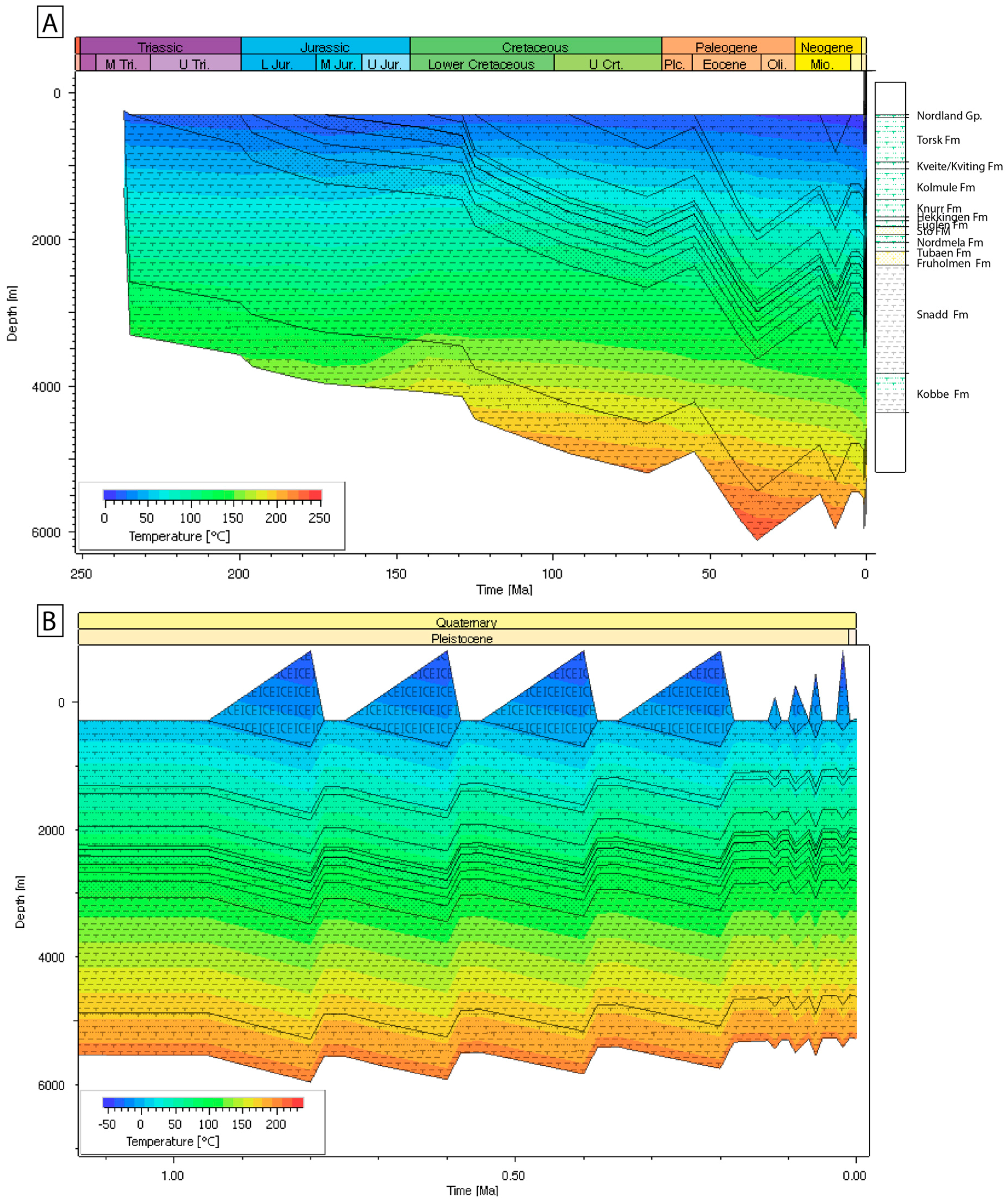

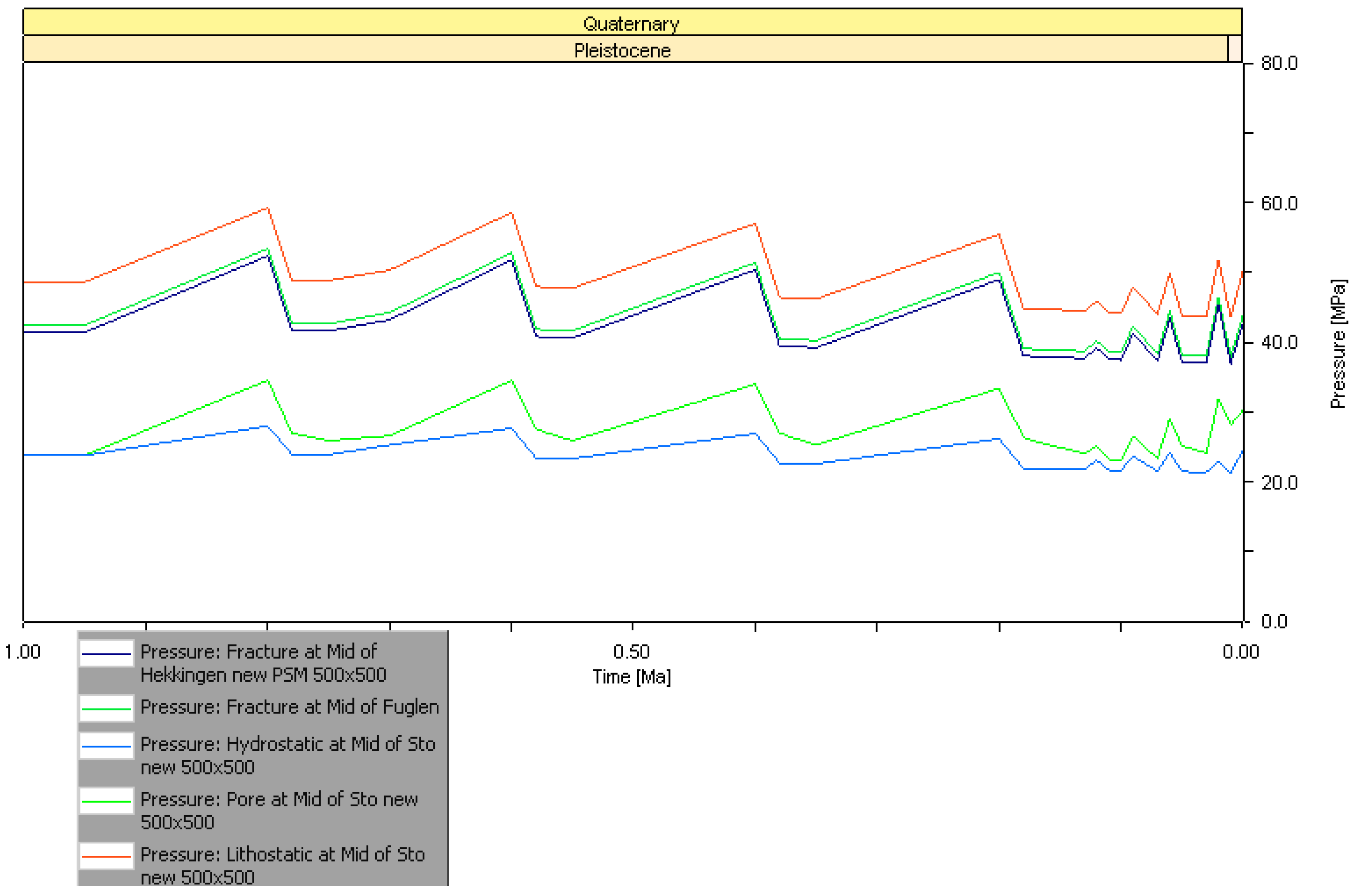
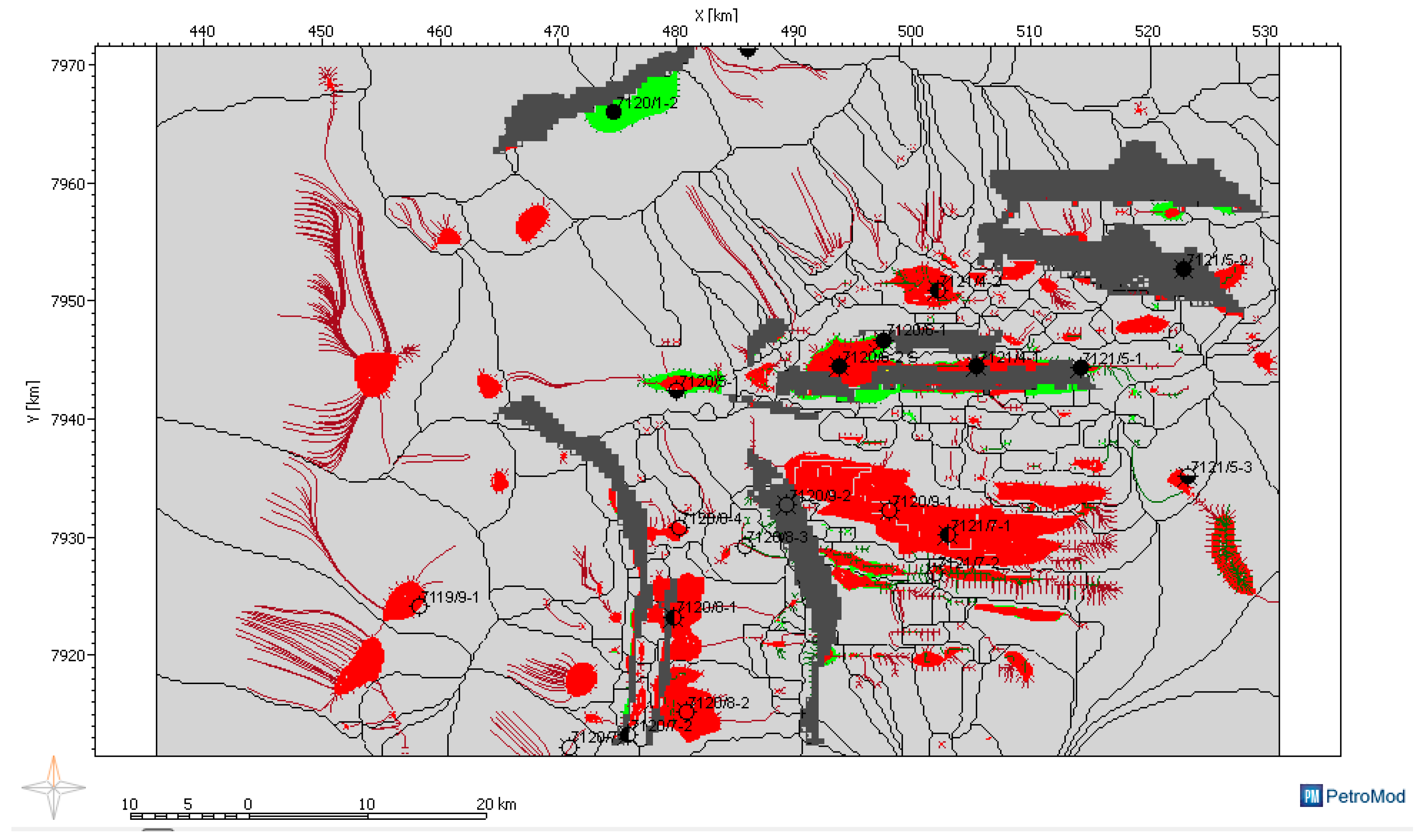
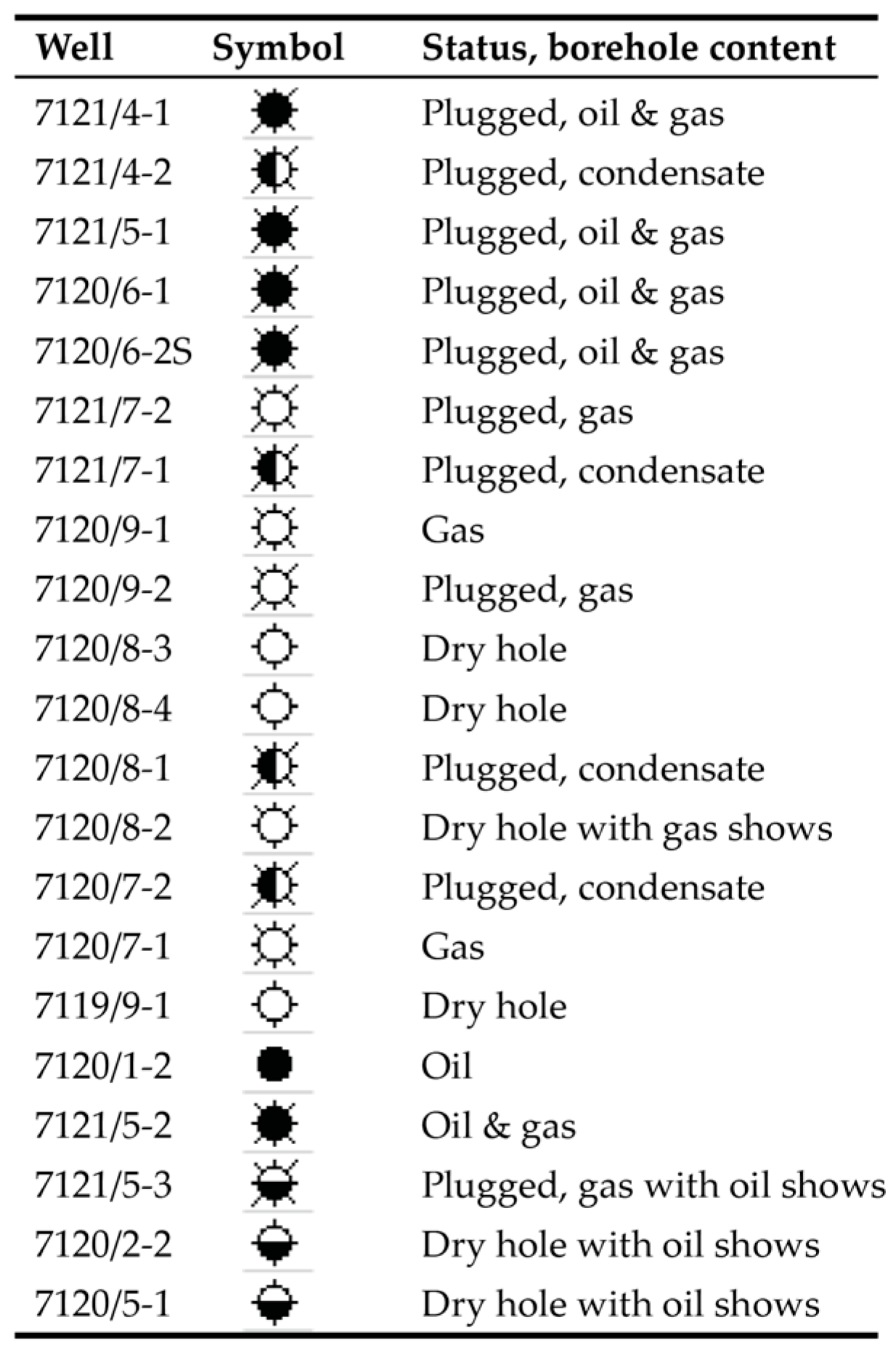

References
- Dore, A.G. Barents Sea Geology, Petroleum Resources and Commercial Potential. Arctic 1995, 48, 207–221. [Google Scholar] [CrossRef]
- Doré, A.G. The structural foundation and evolution of Mesozoic seaways between Europe and the Arctic. Palaeogeogr. Palaeoclimatol. Palaeoecol. 1991, 87, 441–492. [Google Scholar] [CrossRef]
- Faleide, J.I.; Tsikalas, F.; Breivik, A.J.; Mjelde, R.; Ritzmann, O.; Engen, O.; Wilson, J.; Eldholm, O. Structure and evolution of the continental margin off Norway and Barents Sea. Episodes 2008, 31, 82–91. [Google Scholar]
- Smelror, M.; Petrov, O.V.; Larsen, G.B.; Werner, S.E. Geological History of the Barents Sea; Geological Survey of Norway: Trondheim, Norway, 2009; 135p. [Google Scholar]
- Ramberg, I.B.; Bryhni, I.; Nottvedt, A.; Rangnes, K. The Making of a Land—The Geology of Norway; Geological Survey of Norway: Trondheim, Norway, 2008; p. 625. [Google Scholar]
- Norwegian Petroleum Directorate (NPD). Available online: http://www.npd.no/en/Topics/ (accessed on 10 December 2016).
- Ohm, S.E.; Karlsen, D.A.; Austin, T.J.F. Geochemically driven exploration models in uplifted areas: Examples from the Norwegian Barents Sea. AAPG Bull. 2008, 92, 1191–1223. [Google Scholar] [CrossRef]
- Estublier, A.; Lackner, A.S. Long-term simulation of the Snøhvit CO2 storage. Energy Procedia 2009, 1, 3221–3228. [Google Scholar] [CrossRef]
- Wennberg, O.P.; Malm, O.; Needham, T.; Edwards, E.; Ottesen, S.; Karlsen, F.; Rennan, L.; Knipe, R. On the occurrence and formation of open fractures in the Jurassic reservoir sandstones of the Snøhvit Field, SW Barents Sea. Pet. Geosci. 2008, 14, 139–150. [Google Scholar] [CrossRef]
- Cavanagh, A.J.; Di Primio, R.; Scheck-Wenderoth, M.; Horsfield, B. Severity and timing of Cenozoic exhumation in the southwestern Barents Sea. J. Geol. Soc. 2006, 163, 761–774. [Google Scholar] [CrossRef]
- Skagen, J.I. Effects on hydrocarbon potential caused by Tertiary uplift and erosion in the Barents Sea. In Artic Geology and Petroleum Potential; Vorren, T.O., Bergsear, E., Dahl-Stammes, O.A., Holter, E., Johansen, B., Lie, E., Lund, T.B., Eds.; Norwegian Petroleum Society Special Publications; Elsevier: Amsterdam, The Netherlands, 1993; Volume 2, pp. 711–719. [Google Scholar]
- Andreassen, K.; Hogstad, K. Gas hydrate in the southern Barents Sea, indicated by a shallow seismic anomaly. First Break 1990, 8, 235–245. [Google Scholar] [CrossRef]
- Linjorded, A.; Grung-Olsen, R. The Jurassic Snøhvit Gas Field, Hammerfest Basin, Offshore Northern Norway. AAPG Mem. 1992, 54, 349–370. [Google Scholar]
- Laberg, J.S.; Andreassen, K. Gas hydrate and free gas indications within the Cenozoic succession of the Bjørnøya Basin, western Barents Sea. Mar. Pet. Geol. 1996, 13, 921–940. [Google Scholar] [CrossRef]
- Chand, S.; Thorsnes, T.; Rise, L.; Brunstad, H.; Stoddart, D.; Bøe, R.; Lågstad, P.; Svolsbru, T. Multiple episodes of fluid flow in the SW Barents Sea (Loppa High) evidenced by gas flares, pockmarks and gas hydrate accumulation. Earth Planet. Sci. Lett. 2012, 331–332, 305–314. [Google Scholar] [CrossRef]
- Ostanin, I.; Anka, Z.; di Primio, R.; Bernal, A. Hydrocarbon plumbing systems above the Snøhvit gas field: Structural control and implications for thermogenic methane leakage in the Hammerfest Basin, SW Barents Sea. Mar. Pet. Geol. 2013, 43, 127–146. [Google Scholar] [CrossRef]
- Ostanin, I.; Anka, Z.; di Primio, R.; Bernal, A. Identification of a large Upper Cretaceous polygonal fault network in the Hammerfest basin: Implications on the reactivation of regional faulting and gas leakage dynamics, SW Barents Sea. Mar. Geol. 2012, 332–334, 109–125. [Google Scholar] [CrossRef]
- Green, P.F.; Duddy, I.R. Synchronous exhumation events around the Arctic including examples from Barents Sea and Alaska North Slope. Geol. Soc. Lond. Pet. Geol. Conf. Ser. 2010, 7, 633–644. [Google Scholar]
- Nyland, B.; Jensen, L.N.; Skagen, J.; Skarpnes, O.; Vorren, T.O. Tertiary uplift and erosion in the Barents Sea—Magnitude, timing and consequences. In Tectonic Modelling and Its Implication to Petroleum Geology; Larsen, R.M., Brekke, H., Larsen, B.T., Talleras, E., Eds.; Norwegian Petroleum Society Special Publications 1; Elsevier: Amsterdam, The Netherlands, 1992; pp. 153–162. [Google Scholar]
- Laberg, J.S.; Andreassen, K.; Vorren, T.O. Late Cenozoic erosion of the high-latitude southwestern Barents Sea shelf revisited. Geol. Soc. Am. Bull. 2012, 214, 77–88. [Google Scholar] [CrossRef]
- Doré, A.G.; Jensen, L.N. The impact of late Cenozoic uplift and erosion on hydrocarbon exploration: Offshore Norway and some other uplifted basins. Glob. Planet. Chang. 1996, 12, 415–436. [Google Scholar] [CrossRef]
- Henriksen, E.; Bjørnseth, H.M.; Hals, T.K.; Heide, T.; Kiryukhina, T.; Kløvjan, O.S.; Larssen, G.B.; Ryseth, A.E.; Rønning, K.; Sollid, K.; et al. Uplift and erosion of the greater Barents Sea: Impact on prospectivity and petroleum systems. Geol. Soc. Lond. Mem. 2011, 35, 271–281. [Google Scholar] [CrossRef]
- Lerche, I.; Yu, Z.; Tørudbakken, B.; Thomsen, R.O. Ice loading effects in sedimentary basins with reference to the Barents Sea. Mar. Pet. Geol. 1997, 14, 277–338. [Google Scholar] [CrossRef]
- Corcoran, D.V.; Dore, A.G. Depressurization of hydrocarbon-bearing reservoirs in exhumed basin settings: Evidence from Atlantic margin and borderland basins. Geol. Soc. Lond. Spec. Publ. 2002, 196, 457–483. [Google Scholar] [CrossRef]
- Zieba, K.J.; Grøver, A. Isostatic response to glacial erosion, deposition and ice loading. Impact on hydrocarbon traps of the southwestern Barents Sea. Mar. Pet. Geol. 2016, 78, 168–183. [Google Scholar] [CrossRef]
- Winsborrow, M.C.M.; Andreassen, K.; Corner, G.D.; Laberg, J.S. Deglaciation of a marine-based ice sheet: Late Weichselian palaeo-ice dynamics and retreat in the southern Barents Sea reconstructed from onshore and offshore glacial geomorphology. Quat. Sci. Rev. 2010, 29, 424–442. [Google Scholar] [CrossRef]
- Rüther, D.C.; Bjarnadóttir, L.R.; Junttila, J.; Husum, K.; Rasmussen, T.L.; Lucchi, R.G.; Andreassen, K. Pattern and timing of the northwestern Barents Sea Ice Sheet deglaciation and indications of episodic Holocene deposition. Boreas 2012, 41, 494–512. [Google Scholar] [CrossRef]
- Siegenthaler, U.; Stocker, T.F.; Monnin, E.; Lüthi, D.; Schwander, J.; Stauffer, B.; Raynaud, D.; Barnola, J.-M.; Fischer, H.; Masson-Delmotte, V.; et al. Stable Carbon Cycle-Climate Relationship During the Late Pleistocene. Science 2005, 310, 1313–1317. [Google Scholar] [CrossRef] [PubMed]
- Rodrigues Duran, E.; di Primio, R.; Anka, Z.; Stoddart, D.; Horsfield, B. 3D-Basin modelling of the Hammerfest Basin (southwestern Barents Sea): A quantitative assessment of petroleum generation, migration and leakage. Mar. Pet. Geol. 2013, 45, 281–303. [Google Scholar] [CrossRef]
- Ostanin, I.; Anka, Z.; di Primio, R.; Bernal, A. Hydrocarbon leakage above the Snøhvit gas field, Hammerfest Basin SW Barents Sea. First Break 2012, 30, 55–60. [Google Scholar] [CrossRef]
- Klitzke, P.; Luzi-Helbing, M.; Schicks, J.M.; Cacace, M.; Jacquey, A.B.; Sippel, J.; Scheck-Wenderoth, M.; Faleide, J.I. Gas Hydrate Stability Zone of the Barents Sea and Kara Sea Region. Energy Procedia 2016, 97, 302–309. [Google Scholar] [CrossRef]
- Tasianas, A.; Mahl, L.; Darcis, M.; Buenz, S.; Class, H. Simulating seismic chimney structures as potential vertical migration pathways for CO2 in the Snøhvit area, SW Barents Sea: Model challenges and outcomes. Environ. Earth Sci. 2016, 75, 1–20. [Google Scholar] [CrossRef]
- Mohammedyasin, S.M.; Lippard, S.J.; Omosanya, K.O.; Johansen, S.E.; Harishidayat, D. Deep-seated faults and hydrocarbon leakage in the Snøhvit Gas Field, Hammerfest Basin, Southwestern Barents Sea. Mar. Pet. Geol. 2016, 77, 160–178. [Google Scholar] [CrossRef]
- Chand, S.; Knies, J.; Baranwal, S.; Jensen, H.; Klug, M. Structural and stratigraphic controls on subsurface fluid flow at the Veslemøy High, SW Barents Sea. Mar. Pet. Geol. 2014, 57, 494–508. [Google Scholar] [CrossRef]
- Gabrielsen, R.H.; Faerseth, R.B.; Jensen, L.N.; Kalheim, J.E.; Riis, F. Structural Elements of the Norwegian Continental Shelf Part 1: The Barents Sea Region; Norwegian Petroleum Directorate Bulletin 6; Norwegian Petroleum Directorate: Stavanger, Norway, 1990; p. 33. [Google Scholar]
- Harland, W.B. The Geology of Svalbard, The Geological Society Memoir No. 17; Geological Society: Bath, UK, 1998; p. 525. [Google Scholar]
- Worsley, D. The post-Caledonian development of Svalbard and the western Barents Sea. Pol. Res. 2008, 27, 298–317. [Google Scholar] [CrossRef]
- Ramberg, I.B.; Bryhni, I.; Nottvedt, A.; Rangnes, K. The Making of a Land—Geology of Norway; Norsk Geologisk Forening (Norwegian Geological Association): Trondheim, Norway, 2008; p. 625. [Google Scholar]
- Knutsen, S.M.; Vorren, T.O. Early Cenozoic Sedimentation In The Hammerfest Basin. Mar. Geol. 1991, 101, 31–48. [Google Scholar] [CrossRef]
- Dalland, W.K. Lithostratigraphic Lexicon of Svalbard. Review and Recommendations for Nomenclature Use. Upper Paleozoic to Quaternary Bedrock; Norsk Polarinstitutt: Tromsø, Norway, 1999; 325 p. [Google Scholar]
- Knies, J.; Matthiessen, J.; Vogt, C.; Laberg, J.S.; Hjelstuen, B.O.; Smelror, M.; Larsen, E.; Andreassen, K.; Eidvin, T.; Vorren, T.O. The Plio-Pleistocene glaciation of the Barents Sea-Svalbard region: A new model based on revised chronostratigraphy. Quat. Sci. Rev. 2009, 28, 812–829. [Google Scholar] [CrossRef]
- Worsley, D.; Johansen, R.; Kristensen, S.E. The Mesozoic and Cenozoic succession of the Tromsoflaket. In A Litho-Stratigraphic Scheme for the Mesozoic and Cenozoic Sucessions Offshore Mid- and Northern Norway; Dalland, A., Worsley, D., Ofstad, K., Eds.; Norwegian Petroleum Directorate (NPD) Bulletin 4; Norwegian Petroleum Directorate: Stavanger, Norway, 1988; Volume 4, pp. 42–65. [Google Scholar]
- Solheim, A.; Kristoffersen, Y. The Physical Environment Western Barents Sea, 1:500000. Sediments above the Upper Regional Unconformity: Thickness, Seismic Stratigraphy and Outline of the Glacial History; Norsk Polarinsitutt Skr.: Tromsø, Norway, 1984; Volume 179B. [Google Scholar]
- Eidvin, T.; Jansen, E.; Riis, F. Chronology of Tertiary fan deposits off the western Barents Sea: Implications for the uplift and erosion history of the Barents Shelf. Mar. Geol. 1993, 112, 109–131. [Google Scholar] [CrossRef]
- Knutsen, S.-M.; Richarden, G.; Vorren, T.O. Late Miocene-Pleistocene sequence stratigraphy and mass-movements on the western Barents Sea margin. In Arctic Geology and Petroleum Potential; Vorren, T.O., Bergsaker, E., Dahl-Stamnes, O.A., Holter, E., Lie, E., Johansen, B., Lund, T.B., Eds.; Norwegian Petroleum Society Special Publications; Elsevier: Amsterdam, The Netherlands, 1992; pp. 573–607. [Google Scholar]
- Berglund, L.T.; Augustson, J.; Faerseth, R.; Gjelberg, J.G.; Ramberg-Moe, H. The evolution of the Hammerfest Basin. In Habitat of Hydrocarbons on the Norwegian Continental Shelf; Graham & Trotman: London, UK, 1986; pp. 319–338. [Google Scholar]
- Vorren, T.O.; Landvik, J.Y.; Andreassen, K.; Laberg, J.S. Glacial History of the Barents Sea Region. In Developments in Quaternary Sciences; Jürgen Ehlers, P.L.G., Philip, D.H., Eds.; Elsevier: Amsterdam, The Netherlands, 2011; Chapter 27; Volume 15, pp. 361–372. [Google Scholar]
- Hantschel, A.; Kauerauf, T. Fundamentals of Basin and Petroleum Systems Modelling; Springer: Berlin/Heidelberg, Germany, 2009. [Google Scholar]
- Siegert, M.J.; Dowdeswell, J.A.; Hald, M.; Svendsen, J.-I. Modelling the Eurasian Ice Sheet through a full (Weichselian) glacial cycle. Glob. Planet. Chang. 2001, 31, 367–385. [Google Scholar] [CrossRef]
- Rüther, D.C.; Mattingsdal, R.; Andreassen, K.; Forwick, M.; Husum, K. Seismic architecture and sedimentology of a major grounding zone system deposited by the Bjørnøyrenna Ice Stream during Late Weichselian deglaciation. Quat. Sci. Rev. 2011, 30, 2776–2792. [Google Scholar] [CrossRef]
- Kukla, G.; Cílek, V. Plio-Pleistocene megacycles: Record of climate and tectonics. Palaeogeogr. Palaeoclimatol. Palaeoecol. 1996, 120, 171–194. [Google Scholar] [CrossRef]
- Svendsen, J.I.; Alexanderson, H.; Astakhov, V.I.; Demidov, I.; Dowdeswell, J.A.; Funder, S.; Gataullin, V.; Henriksen, M.; Hjort, C.; Houmark-Nielsen, M.; et al. Late Quaternary ice sheet history of northern Eurasia. Quat. Sci. Rev. 2004, 23, 1229–1271. [Google Scholar] [CrossRef]
- Sloan, E.D. Clathrate Hydrates of Natural Gases; Marcel Dekker: New York, NY, USA, 1990. [Google Scholar]
- Norwegian Petroleum Directorate (NPD). Norwegian Petroleum Directorate Factmaps. Available online: http://npdmap1.npd.no/website/npdgis/viewer.htm (accessed on 10 June 2011).
- Caine, J.S.; Evans, J.P.; Forster, C.B. Fault zone architecture and permeability structure. Geology 1996, 24, 1025–1028. [Google Scholar] [CrossRef]
- Sibson, R.H. Fluid involvement in normal faulting. J. Geodyn. 2000, 29, 469–499. [Google Scholar] [CrossRef]
- Faulkner, D.R.; Jackson, C.A.L.; Lunn, R.J.; Schlische, R.W.; Shipton, Z.K.; Wibberley, C.A.J.; Withjack, M.O. A review of recent developments concerning the structure, mechanics and fluid flow properties of fault zones. J. Struct. Geol. 2010, 32, 1557–1575. [Google Scholar] [CrossRef]
- Aydin, A. Fractures, faults, and hydrocarbon entrapment, migration and flow. Mar. Pet. Geol. 2000, 17, 797–814. [Google Scholar] [CrossRef]
- Morris, A.; Ferrill, D.A.; Henderson, D.B. Slip-tendency analysis and fault reactivation. Geology 1996, 24, 275–278. [Google Scholar] [CrossRef]
- Freeman, B.; Yielding, G.; Needham, D.T.; Badley, M.E. Fault seal prediction: The gouge ratio method. Geol. Soc. Lond. Spec. Publ. 1998, 127, 19–25. [Google Scholar] [CrossRef]
- Needham, D.T.; Yielding, G.; Freeman, B. Analysis of fault geometry and displacement patterns. Geol. Soc. Lond. Spec. Publ. 1996, 99, 189–199. [Google Scholar] [CrossRef]
- Knipe, R.J. The influence of fault zone processes and diagenesis on fluid flow. In Diagenesis and Basin Development: AAPG Studies in Geology; Horbury, A.D., Robinson, A.D., Eds.; The American Association of Petroleum Geologists: Tulsa, OK, USA, 1993; Volume 36, pp. 135–151. [Google Scholar]
- Fisher, Q.J.; Harris, S.D.; McAllister, E.; Knipe, R.J.; Bolton, A.J. Hydrocarbon flow across faults by capillary leakage revisited. Mar. Pet. Geol. 2001, 18, 251–257. [Google Scholar] [CrossRef]
- Manzocchi, T.; Childs, C.; Walsh, J.J. Faults and fault properties in hydrocarbon flow models. Geofluids 2010, 10, 94–113. [Google Scholar] [CrossRef]
- Sorkhabi, R.; Tsuji, Y. The Place of Faults in Petroleum Traps. In Faults, Fluid Flow, and Petroleum Traps; Sorkhabi, R., Tsuji, Y., Eds.; AAPG Memoir 85; AAPG: Tulsa, OK, USA, 2005. [Google Scholar]
- Sperrevik, S.; Gillespie, P.A.; Fisher, Q.J.; Halvorsen, T.; Knipe, R.J. Empirical estimation of fault rock properties. Nor. Pet. Soc. Spec. Publ. 2002, 11, 109–125. [Google Scholar]
- Ingram, G.M.; Urai, J.L.; Naylor, M.A. Sealing processes and top seal assessment. In Hydrocarbon Seals—Importance for Exploration and Production; Møller-Pedersen, P., Koestler, A.G., Eds.; Norwegian Petroleum Society Special Publications: Trondheim, Norway, 1997; Volume 7, pp. 165–174. [Google Scholar]
- Zatsepin, S.V.; Crampin, S. Modelling the compliance of crustal rock—I. Response of shear-wave splitting to differential stress. Geophys. J. Int. 1997, 129, 477–494. [Google Scholar] [CrossRef]
- Fjeldskaar, W.; Lindholm, C.; Dehls, J.F.; Fjeldskaar, I. Postglacial uplift, neotectonics and seismicity in Fennoscandia. Q. Sci. Rev. 2000, 19, 1413–1422. [Google Scholar] [CrossRef]
- Bjorlykke, K.; Hoeg, K.; Faleide, J.I.; Jahren, J. When do faults in sedimentary basins leak? Stress and deformation in sedimentary basins; examples from the North Sea and Haltenbanken, offshore Norway. AAPG Bull. 2005, 89, 1019–1031. [Google Scholar] [CrossRef]
- Ligtenberg, J.H. Detection of fluid migration pathways in seismic data: Implications for fault seal analysis. Basin Res. 2005, 17, 141–153. [Google Scholar] [CrossRef]
- Wiprut, D.; Zoback, M.D. Fault reactivation and fluid flow along a previously dormant normal fault in the northern North Sea. Geology 2000, 28, 595–598. [Google Scholar] [CrossRef]
- Mattos, N.H.; Alves, T.M.; Omosanya, K.O. Crestal fault geometries reveal late halokinesis and collapse of the Samson Dome, Northern Norway: Implications for petroleum systems in the Barents Sea. Tectonophysics 2016, 690(Part A), 76–96. [Google Scholar] [CrossRef]
- Yielding, G.; Bretan, P.; Freeman, B. Fault seal calibration: A brief review. In Reservoir Compartmentalization; Jolley, S.J., Fisher, Q.J., Ainsworth, R.B., Vrolijk, P.J., Delisle, S., Eds.; Geological Society Special Publications: London, UK, 2010; Volume 347, pp. 243–255. [Google Scholar]
- Dore, A.G.; Corcoran, D.V.; Scotchman, I.C. Prediction of the hydrocarbon system in exhumed basins, and application to the NW European margin. Geol. Soc. Lond. Spec. Publ. 2002, 196, 401–429. [Google Scholar] [CrossRef]
- Grollimund, B.; Zoback, M.D.; Wiprut, D.J.; Arnesen, L. Stress orientation, pore pressure and least principal stress in the Norwegian sector of the North Sea. Pet. Geosci. 2001, 7, 173–180. [Google Scholar] [CrossRef]
- Ekström, G.; Nettles, M.; Abers, G.A. Glacial Earthquakes. Science 2003, 302, 622–624. [Google Scholar] [CrossRef] [PubMed]
- Arvidsson, R. Fennoscandian Earthquakes: Whole Crustal Rupturing Related to Postglacial Rebound. Science 1996, 274, 744–746. [Google Scholar] [CrossRef]
- Stewart, I.S.; Sauber, J.; Rose, J. Glacio-seismotectonics: Ice sheets, crustal deformation and seismicity. Quat. Sci. Rev. 2000, 19, 1367–1389. [Google Scholar] [CrossRef]
- Bolas, H.M.N.; Hermanrud, C.; Teige, G.M.G. The Influence of Stress Regimes on Hydrocarbon Leakage. In AAPG Special Volumes 2005, AAPG Hedberg Series, No. 2: Evaluating Fault and Cap Rock Seals; The American Association of Petroleum Geologists: Tulsa, OK, USA; pp. 109–123.
- Vassenden, F.; Sylta, Ø.; Zwach, C. Secondary migration in a 2D visual laboratory model. In Proceedings of the Conference: Faults and Top Seals, EAGE 2003, Montpellier, France, 8–11 September 2003. [Google Scholar]
- Schowalter, T.T. Mechanics of secondary hydrocarbon migration and entrapment. Am. Assoc. Pet. Geol. Bull. 1979, 63, 723–760. [Google Scholar]
- Fauria, K.E.; Rempel, A.W. Gas invasion into water-saturated, unconsolidated porous media: Implications for gas hydrate reservoirs. Earth Planet. Sci. Lett. 2011, 312, 188–193. [Google Scholar] [CrossRef]
- Bünz, S.; Vadakkepuliyambatta, S.; Mienert, J.; Eriksen, O.K.; Eriksen, F.; Planke, S. P-Cable High-Resolution 3D Seismic Imaging of Hydrate Occurrences over unusually Large Gas Chimneys in the SW Barents Sea. Fire Ice Newsl. 2012, 12, 10–13. [Google Scholar]
- Nickel, J.C.; di Primio, R.; Mangelsdorf, K.; Stoddart, D.; Kallmeyer, J. Characterization of microbial activity in pockmark fields of the SW-Barents Sea. Mar. Geol. 2012, 332–334, 152–162. [Google Scholar] [CrossRef]
- Hermanrud, C.; Halkjelsvik, M.E.; Kristiansen, K.; Bernal, A.; Stromback, A.C. Petroleum column-height controls in the western Hammerfest Basin, Barents Sea. Pet. Geosci. 2014, 20, 227–240. [Google Scholar] [CrossRef]
- Gartrell, A.; Zhang, Y.; Lisk, M.; Dewhurst, D. Enhanced hydrocarbon leakage at fault intersections: An example from the Timor Sea, Northwest Shelf, Australia. J. Geochem. Explor. 2003, 78–79, 361–365. [Google Scholar] [CrossRef]
- Solheim, A.; Elverhøi, A. Gas-related sea floor craters in the Barents Sea. Geo-Mar. Lett. 1993, 13, 235–243. [Google Scholar] [CrossRef]
- Fichler, C.; Henriksen, S.; Rueslaatten, H.; Hovland, M. North Sea Quaternary morphology from seismic and magnetic data: Indications for gas hydrates during glaciation? Pet. Geosci. 2005, 11, 331–337. [Google Scholar] [CrossRef]
- Lerche, I.; Bagirov, E. Guide to gas hydrate stability in various geological settings. Mar. Pet. Geol. 1998, 15, 427–437. [Google Scholar] [CrossRef]
- Judd, A.G.; Hovland, M. Seabed Fluid Flow; Cambridge University Press: Cambridge, UK, 2007; p. 476. [Google Scholar]
- Ostanin, I. Hydrocarbon Plumbing Systems and Leakage Phenomenon in the Hammerfest Basin, Southwest Barents Sea. Ph.D. Thesis, Technical University Berlin, Berlin, Germany, 2015. [Google Scholar]
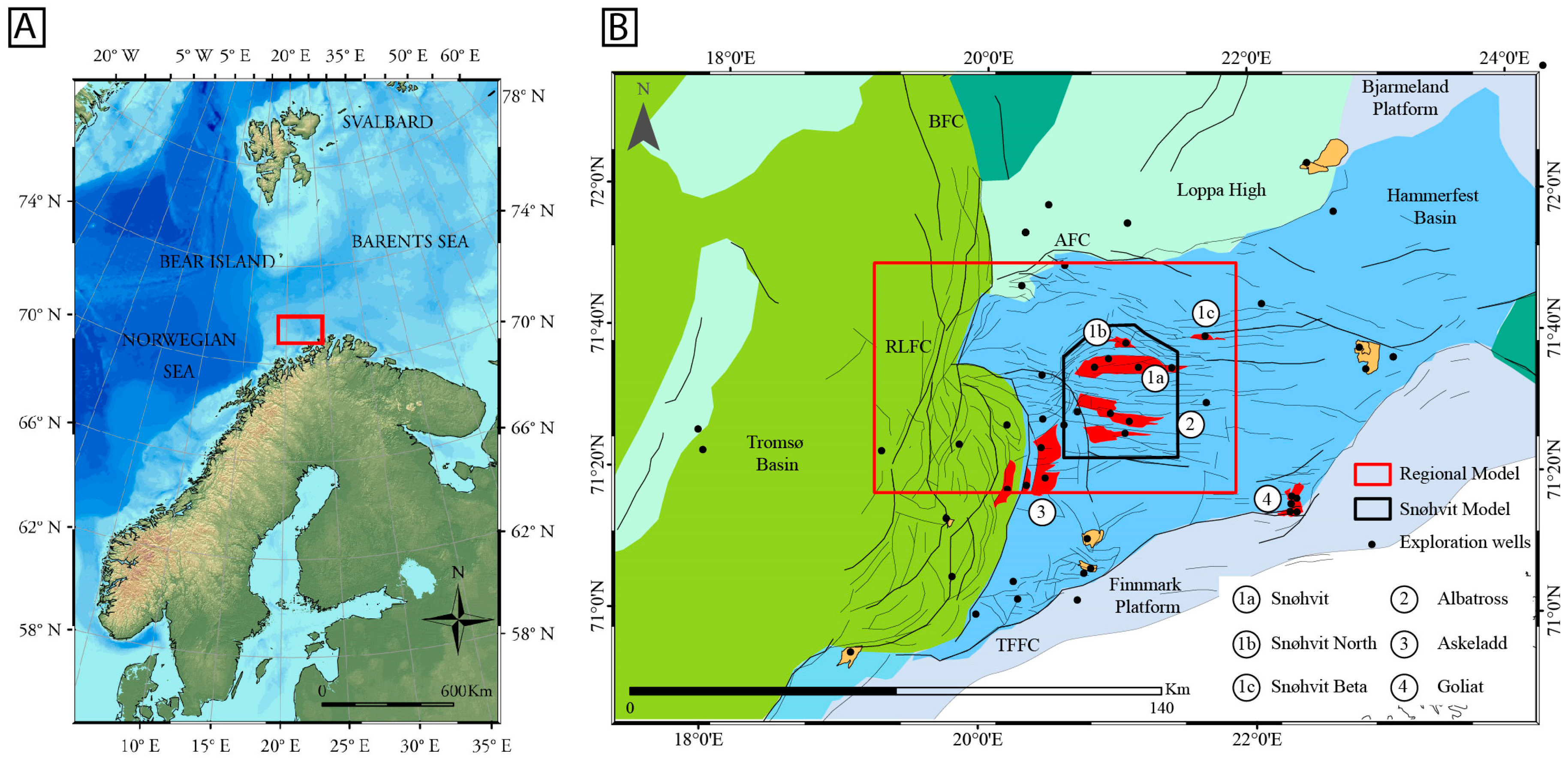
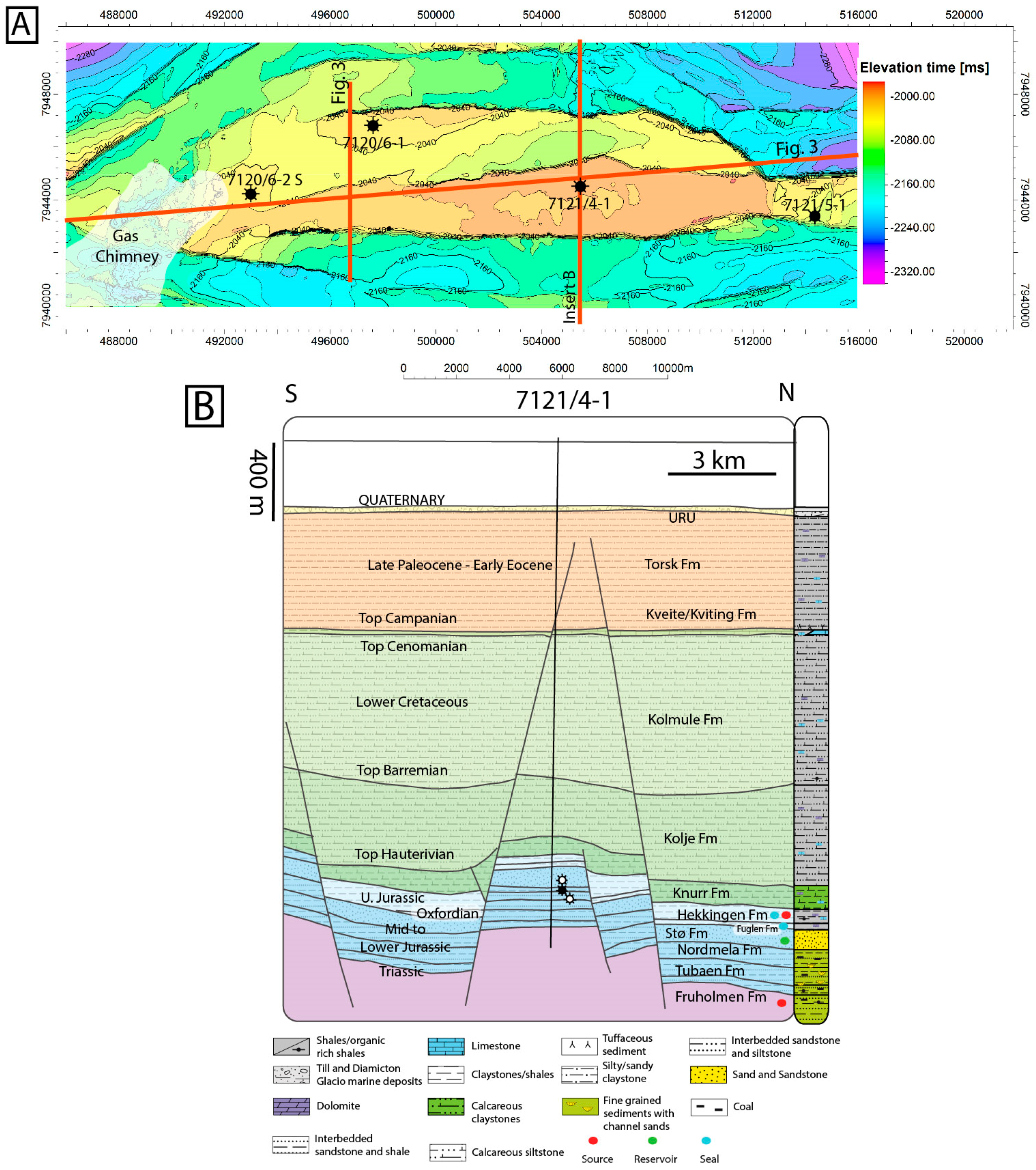


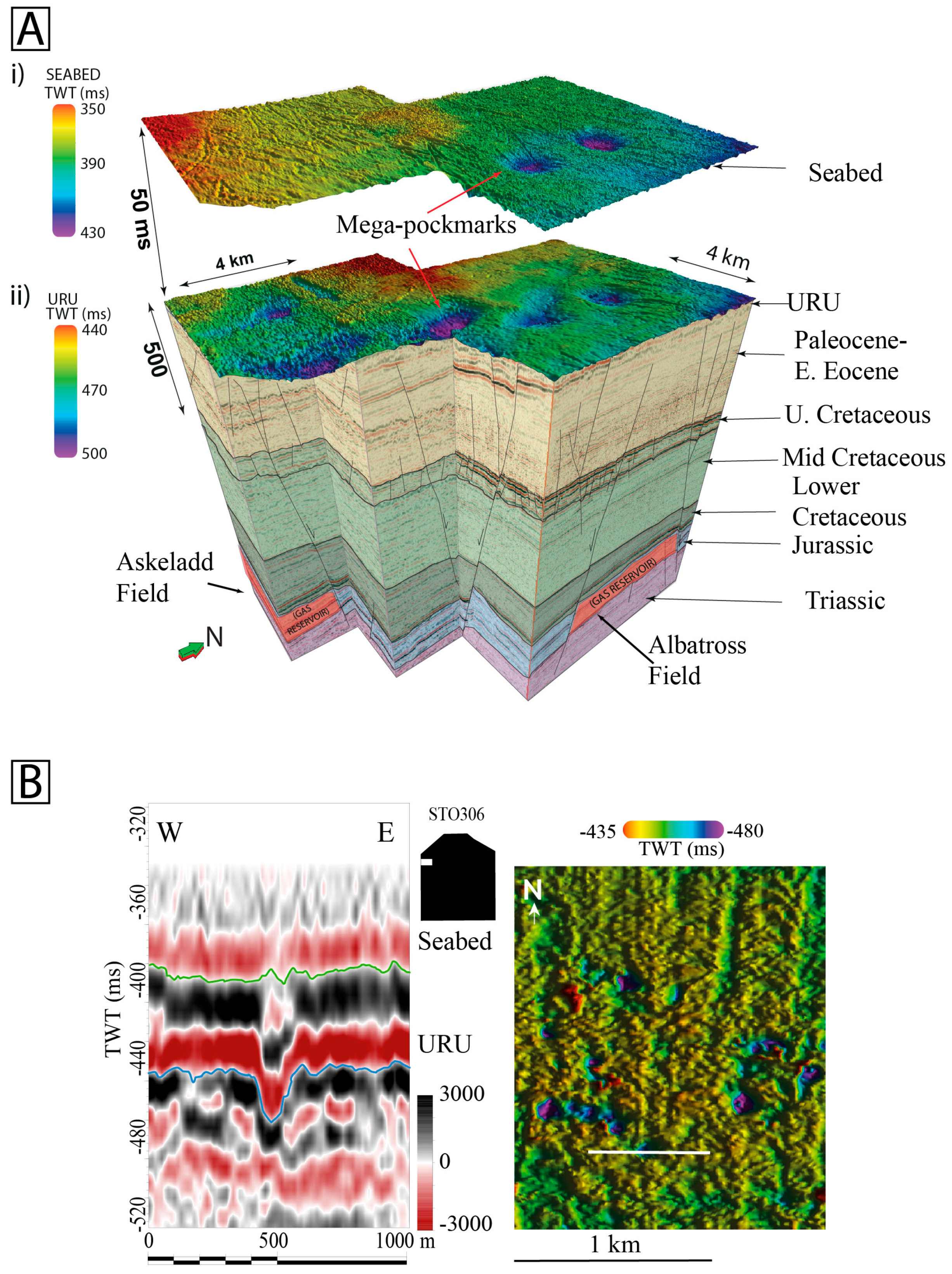
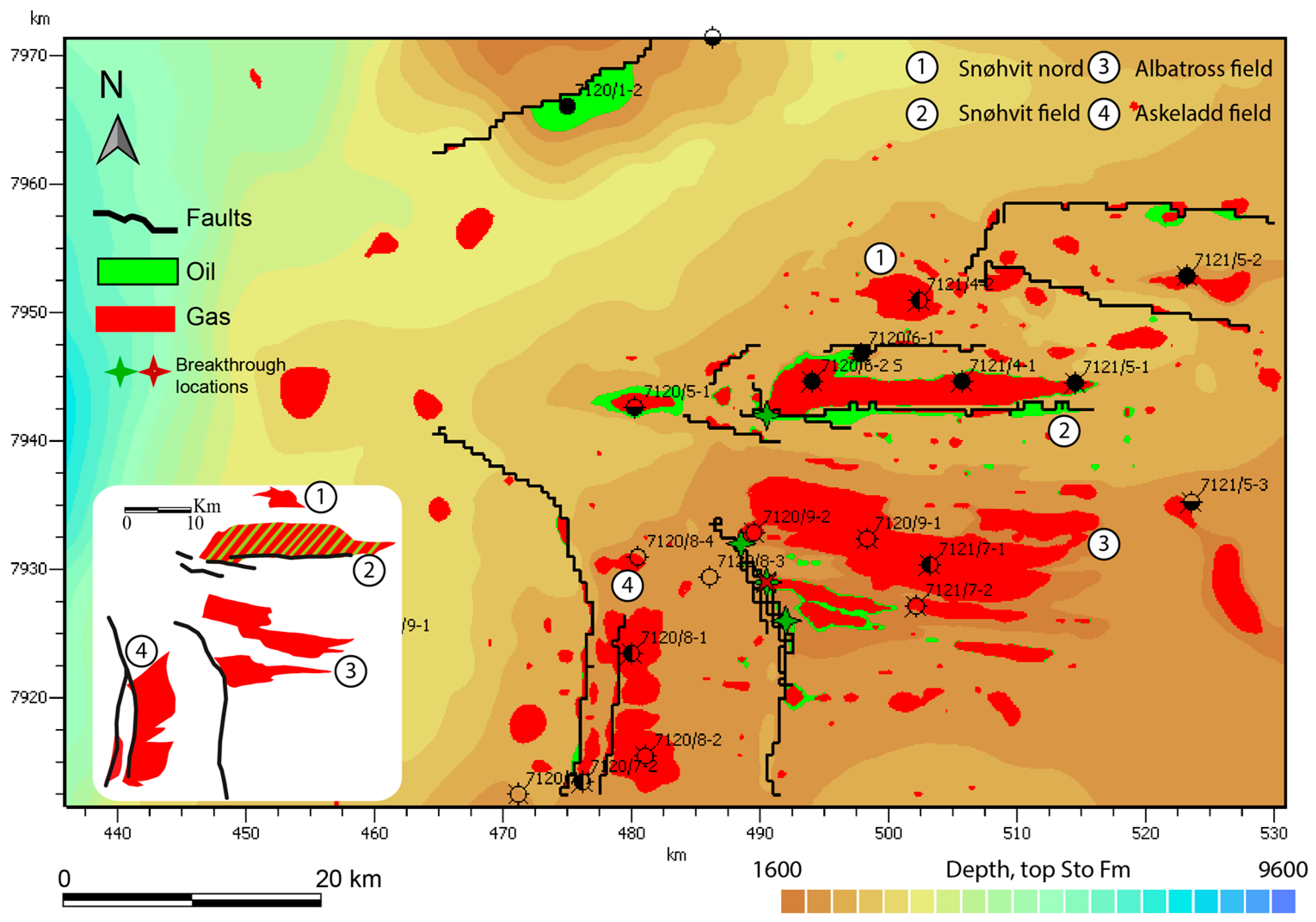
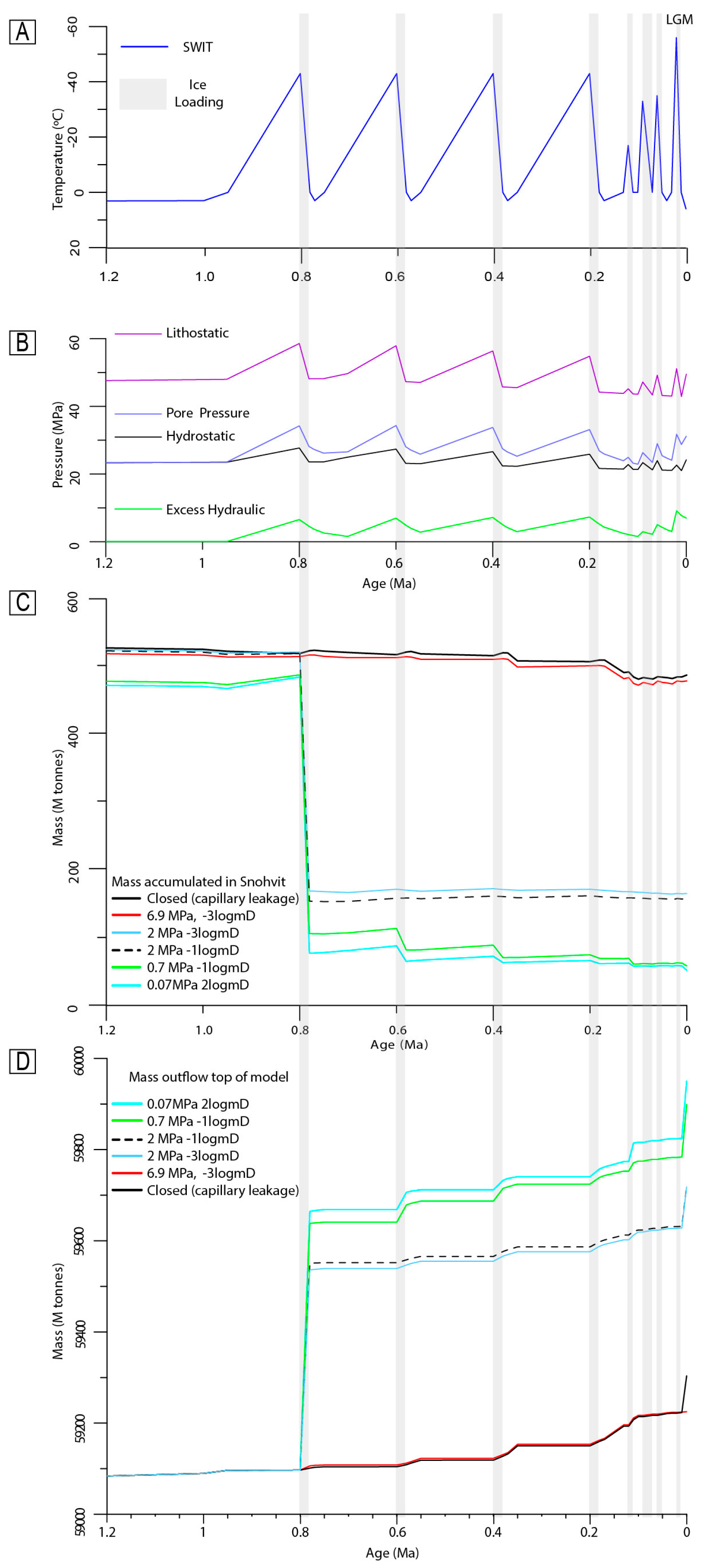
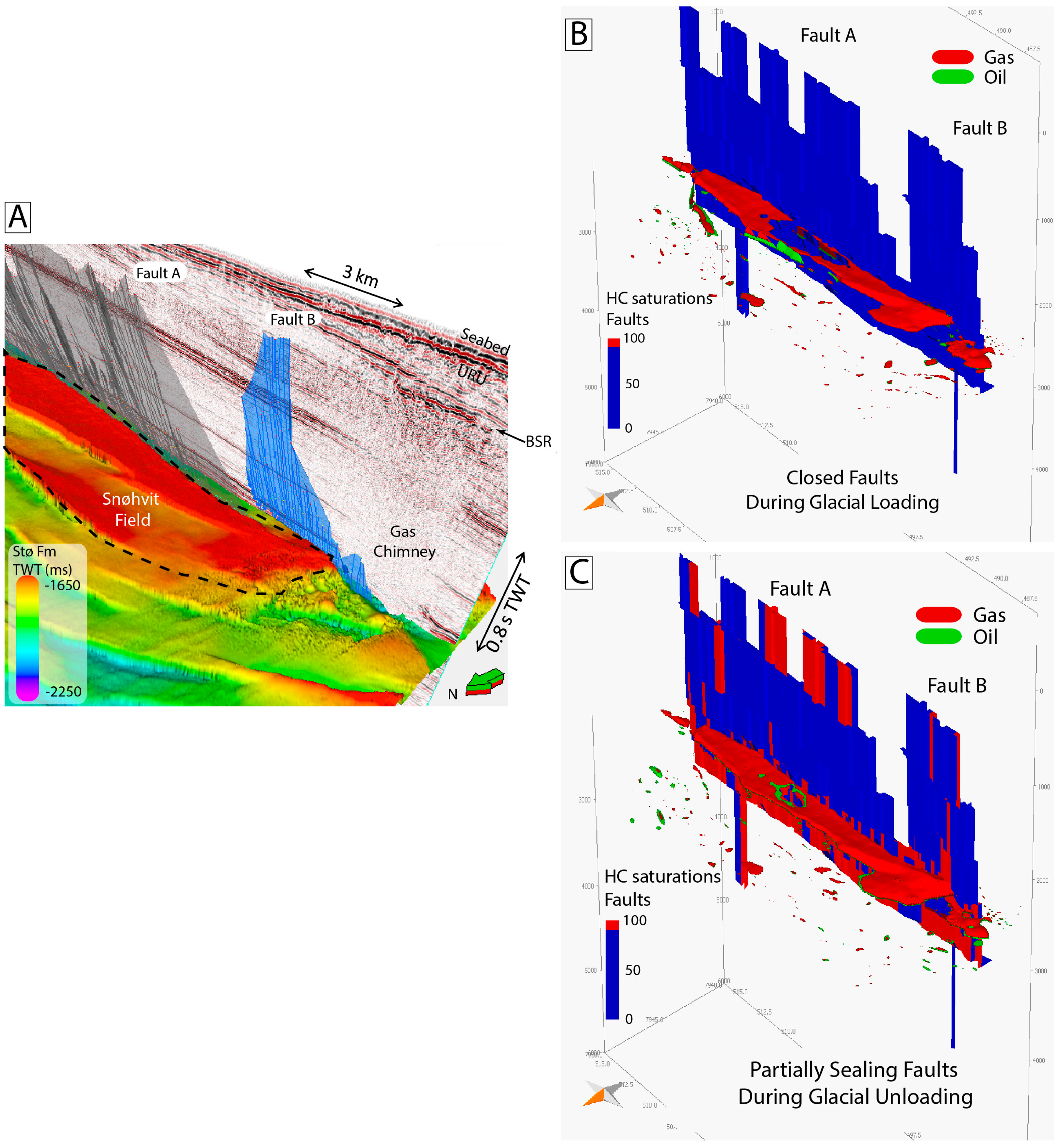
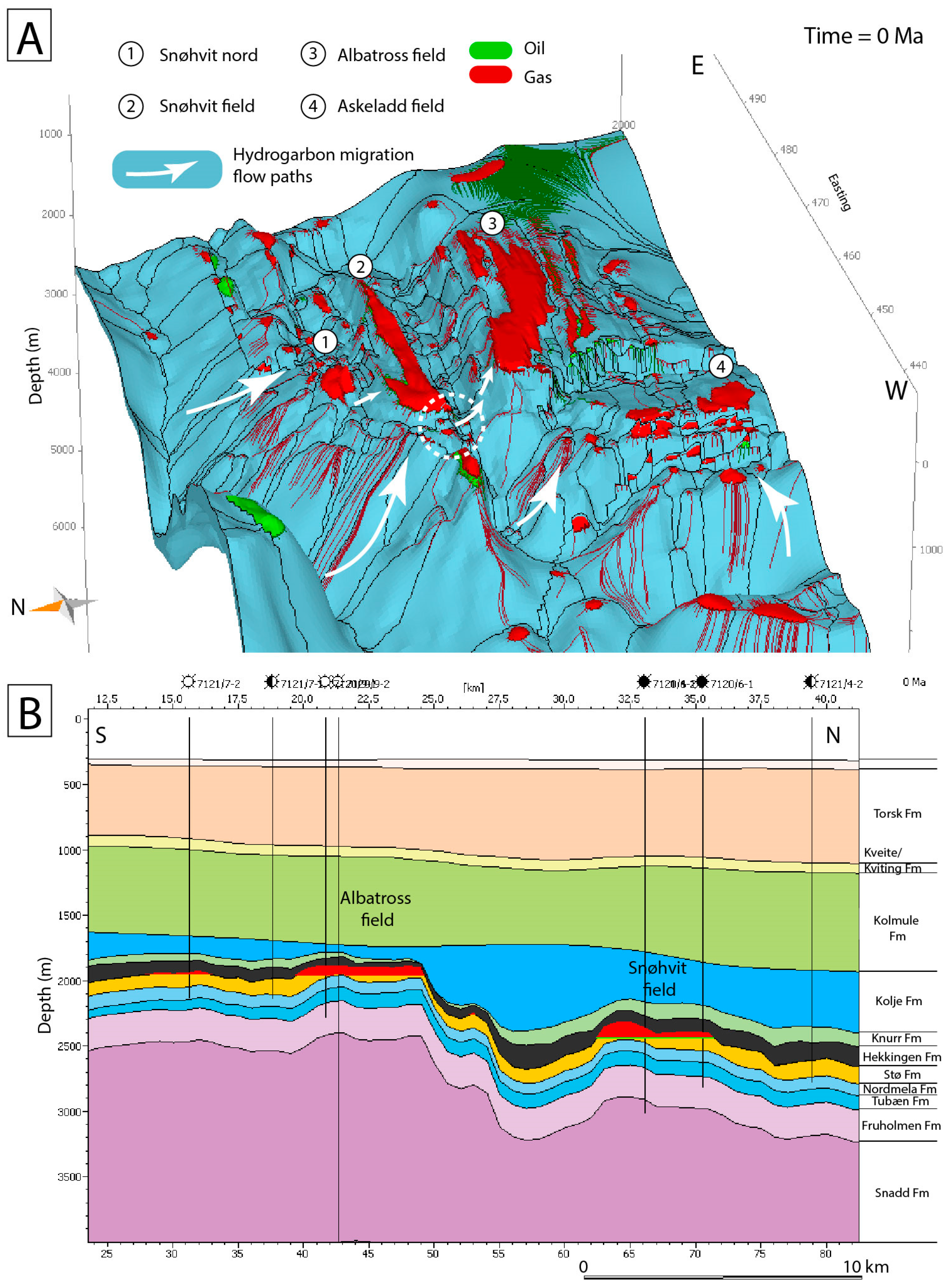

| FCP * | Permeability (log mD **) | Permeability (mD **) |
|---|---|---|
| Closed | - | - |
| 6.9 | −3 | 0.001 |
| 2 | −3 | 0.001 |
| 2 | −1 | 0.1 |
| 0.7 | −1 | 0.1 |
| 0.07 | 2 | 100 |
| Conductive Faults | Closed Faults | ||
|---|---|---|---|
| Age * from | Age up to | Age From | Age up to |
| 0.8 | 0.78 | 150 | 0.8 |
| 0.6 | 0.58 | 0.78 | 0.6 |
| 0.4 | 0.38 | 0.58 | 0.4 |
| 0.2 | 0.18 | 0.38 | 0.2 |
| 0.12 | 0.11 | 0.18 | 0.12 |
| 0.09 | 0.07 | 0.11 | 0.09 |
| 0.06 | 0.05 | 0.07 | 0.06 |
| 0.02 | 0 | 0.05 | 0.02 |
© 2017 by the authors. Licensee MDPI, Basel, Switzerland. This article is an open access article distributed under the terms and conditions of the Creative Commons Attribution (CC BY) license (http://creativecommons.org/licenses/by/4.0/).
Share and Cite
Ostanin, I.; Anka, Z.; Di Primio, R. Role of Faults in Hydrocarbon Leakage in the Hammerfest Basin, SW Barents Sea: Insights from Seismic Data and Numerical Modelling. Geosciences 2017, 7, 28. https://doi.org/10.3390/geosciences7020028
Ostanin I, Anka Z, Di Primio R. Role of Faults in Hydrocarbon Leakage in the Hammerfest Basin, SW Barents Sea: Insights from Seismic Data and Numerical Modelling. Geosciences. 2017; 7(2):28. https://doi.org/10.3390/geosciences7020028
Chicago/Turabian StyleOstanin, Ilya, Zahie Anka, and Rolando Di Primio. 2017. "Role of Faults in Hydrocarbon Leakage in the Hammerfest Basin, SW Barents Sea: Insights from Seismic Data and Numerical Modelling" Geosciences 7, no. 2: 28. https://doi.org/10.3390/geosciences7020028




